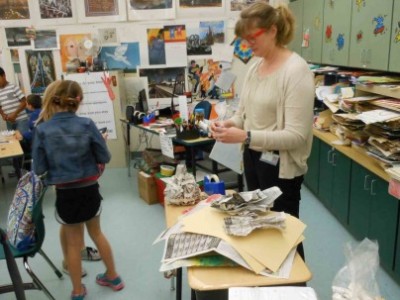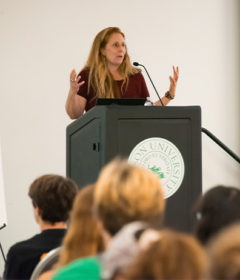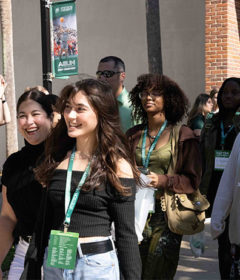Developing Future DaVincis
 A new after-school club is known for both its forward-thinking teaching methods and for the fun way it draws elementary students into the imaginative worlds of reading and artistic expression.
A new after-school club is known for both its forward-thinking teaching methods and for the fun way it draws elementary students into the imaginative worlds of reading and artistic expression.
The DaVinci Club, a school program at Blue Lake Elementary sponsored by a Stetson Nina B. Hollis Institute research effort and funds, helps foster a love of reading as well as the arts. (Barbara Wells, art teacher at Blue Lake Elementary School, one of Stetson’s Professional Development Schools, pictured, creates art with fifth-graders. Photo by Doug MacIsaac.)
Every Tuesday and Thursday afternoon, fourth- and fifth-graders make their way to this voluntary after school program.
Hollis Institute team members and education professors Mercedes Tichenor, Ed.D., Kathy Piechura-Couture, Ph.D., Doug MacIsaac, Ed.S., and Bette Heins, Ph.D., help with data analysis, observational data, and writing. They also report on their findings at professional conferences.
Heins, director of the Nina B. Hollis Institute, says, “Many schools have had to decrease the amount of art classes because of budget cuts, so this is our way of putting it back into the curriculum.”
Now in its third year, the club promotes a love for reading and artistic expression.
Nostalgia hits you when you walk into the class because it resembles the classrooms of your childhood.
However, this classroom is different. Some children sit at desks, others at tables, and some even lie on the floor.
It’s their choice.
Robin Diedrichs, a fourth-grade teacher at Blue Lake Elementary who developed the idea for the club and approached the Hollis Institute with the idea, calls the students over to the floor.
Free choice reading is over, and it’s time for book discussion. The children are eager — one even dashes over to his friend and begins talking excitedly about his book.
It’s almost as if they all want to tell everyone about their books immediately. It’s easy to see their passion for reading.
Diedrichs kicks off the discussion for the day: The children are to pair up and tell their partners about their least favorite character in the book.
Many animated conversations ensue as club members express what made their chosen character unlikable as they engage in literary discussion.
These fourth- and fifth-graders are not only improving their reading and comprehension skills, but their communication, listening and planning skills as well.
The second half of the afternoon is spent doing whatever creative endeavor the children are using to represent the book they’re currently reading. This activity includes writing, drama, music, or visual arts, including painting, drawing, collage and sculpture.
Before they begin, they complete a plan that one of the teachers approves.
Then, they are free to make their masterpieces a reality.
The results are impressive. Some of the students’ creations have even been featured in local galleries and art festivals.
Not only are these students improving in academics, but they are also discovering talents they didn’t know they had.
“And we have data that shows improvement in reading,” Heins says. For example, when an Exceptional Student Education fifth-grader joined the club, she surprised everyone when she showed amazing artistic talent — her pieces were featured at a local art show. She also passed the Reading Counts test that went along with her book The Invention of Hugo Cabret by Brian Selznick.
One student, performing in the bottom 30 percent for reading in his grade level, was asked if he would return to the DaVinci Club for his fifth-grade year.
The young student wrote that he would “because when school started I hated reading, but when DaVinci Club started my teacher Mrs. Diedrichs kept pushing me to read.
“I thought reading was boring, but now it shows me a picture in my head that I think is real when I read exciting books.”
Yet another student wrote a letter to Stetson that said, “Since I have started DaVinci Club my grades have gone up to B’s and A’s.”
She went on to thank Stetson for helping fund the club.
“These students exemplify the hope we have for all students who participate in the DaVinci Club,” Diedrichs asserts.
Stetson’s Hollis Institute provides funds and volunteers to support the club. Several students in the education degree program volunteer weekly, gaining valuable experience for their future careers.
The club’s impact doesn’t stop with the students or the volunteers, however. Every year, they walk in the DeLand Christmas Parade and hand out free books to other children in the community.
This gives them firsthand experience in giving back.
Blue Lake Elementary is a Title I school, which means that many of the students’ families are at or below the poverty level.
Having a club such as this one gives these children opportunities they wouldn’t otherwise be able to afford, according to Heins.
Research shows that it’s difficult for these kids to ever catch up, whether it is in reading levels or figuring out long-term goals.
The DaVinci Club has helped to turn around this research and open up a better academic and personal future for the students involved.
“It is exciting to visit this program and listen to these students talk about their books with such enthusiasm,” declares Heins. In this way, the students become passionate about books and art. “They eagerly show you their art and how it depicts their books. The atmosphere is electric with their joy and passion.”
by Kalee Ball
Stetson Magazine, Summer Issue 2014



